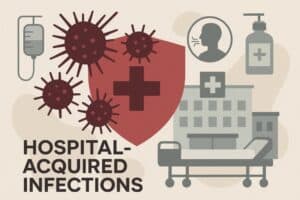Hospitals are meant to be places of healing, yet they can also harbor invisible dangers. Professionals at The Dormer Harpring team who have handled too many wrongful death cases attest that hospital-acquired infections, or HAIs, affect millions of patients worldwide each year, complicating recovery and in some cases leading to serious illness or death. These infections can affect anyone, from surgical patients to newborns, and understanding their risks is essential for both patients and their families. While medical advances have reduced many dangers, HAIs remain a significant concern that demands attention and action.
What Are Hospital-Acquired Infections?
Hospital-acquired infections are infections patients develop while receiving treatment for other conditions in a healthcare setting. They are not present at the time of admission and typically appear 48 hours or more after hospitalization. Common types include urinary tract infections associated with catheters, surgical site infections, bloodstream infections resulting from IV lines, and pneumonia caused by ventilators. HAIs can be caused by bacteria, viruses, or fungi, and some of these pathogens are resistant to multiple drugs, making treatment more challenging.
Who Is Most at Risk?
Not everyone faces the same risk of HAIs. Patients with weakened immune systems, chronic illnesses, or those undergoing invasive procedures are particularly vulnerable. Elderly patients and premature infants are also at higher risk due to weaker defenses against infection. Even routine procedures can become dangerous if proper infection control protocols are not followed. Awareness of risk factors enables patients and their families to advocate for additional precautions when necessary.
How Infections Spread in Hospitals
Hospital environments, although sterile in appearance, are rife with opportunities for infections to spread. Common pathways include contaminated medical equipment, inadequate hand hygiene by healthcare staff, and airborne particles in patient rooms. Even surfaces like bed rails, doorknobs, and medical devices can harbor harmful bacteria. Hospitals implement strict cleaning and sterilization routines, but lapses can occur, making vigilance crucial.
Preventive Measures for Patients and Families
Preventing HAIs is a shared responsibility between healthcare providers and patients. Patients should feel empowered to ask questions about hand hygiene, the sterilization of equipment, and precautions to take during procedures. Families can assist by ensuring caregivers follow hygiene protocols, keeping patient rooms clean, and monitoring for early signs of infection, such as fever, redness, or unusual discharge. Prompt reporting of symptoms can lead to faster intervention and reduce the risk of complications.
The Consequences of Hospital-Acquired Infections
The impact of HAIs extends beyond longer hospital stays. Infections can delay recovery, increase medical costs, and in severe cases, result in permanent disability or death. Drug-resistant infections, in particular, pose a significant threat because treatment options are limited. For patients and families, the consequences can be devastating, both emotionally and financially. Recognizing the signs of infection and seeking timely medical attention can make a critical difference.
The Role of Healthcare Institutions
Hospitals have a legal and ethical obligation to maintain a safe environment. Many institutions implement infection control committees, routine staff training, and implement monitoring programs to track infection rates. Accreditation organizations also evaluate hospitals based on adherence to safety protocols. Transparency in reporting infections and corrective actions helps maintain accountability and protect patient health.
Taking Action if an Infection Occurs
If a hospital-acquired infection leads to serious complications or death, families may have legal recourse. Medical negligence or lapses in infection control can form the basis of a wrongful death claim. Consulting with The Dormer Harpring team can help determine if legal action is appropriate, ensuring accountability while supporting affected families during difficult times.
Final Thoughts
Hospital-acquired infections may be hidden, but their consequences are real and preventable. Awareness, advocacy, and vigilance are essential for anyone entering a healthcare setting. By understanding the risks, asking the right questions, and monitoring care, patients and families can reduce the likelihood of infection. If an infection causes severe harm or death, talking to a wrongful death lawyer can provide guidance and help families seek justice while ensuring that hospitals maintain safer environments for all patients.






